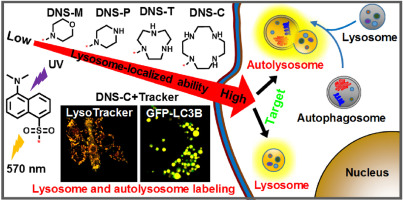Talanta ( IF 5.6 ) Pub Date : 2020-03-23 , DOI: 10.1016/j.talanta.2020.120941 Linlin Yang 1 , Jun Zhao 1 , Jianping Wang 1 , Guangmei Han 2 , Bianhua Liu 1 , Wei Zhang 3 , Yao Fu 4 , Ming-Yong Han 1 , Zhenyang Wang 1 , Zhongping Zhang 2

|
Understanding lysosome-related physiology needs specific lysosome probes to track the biological processes of lysosome in living cells. Here, we report an azacyclo-modified fluorescent probe that has a large Stokes shift, good photostability and negligible cytotoxicity for highly specific labeling of lysosome and autolysosome in living cells. The probes with different kinds of azacyclo groups on parent dye dansyl are screened to show that dansyl-cycleanine (DNS-C) with four nitrogen atoms possesses the best lysosome-localized ability. And DNS-C as a universal tracker exhibits excellent ability for lysosome labeling in different cell lines with high overlap coefficients (≥0.90). Different from a commercially available LysoTracker, the Stokes shift of DNS-C up to 240 nm (λex/em = 330/570 nm), is much larger than that of LysoTracker ∼20 nm (λex/em = 573/595 nm). More importantly, the fluorescence of DNS-C keeps still high brightness after a time-lapsed imaging for 40 min in living cells, implying its remarkable photostability for long-term tracking. In addition, DNS-C can also clearly image the autolysosome, a critical subcellular compartment, forming by the fusion of lysosome with autophagosome in autophagy. These results suggest the promising utility of our probe as a powerful tool to real-time trace physiological processes of lysosomes.
中文翻译:

氮杂环定位荧光探针,用于特异性标记溶酶体和自身溶酶体。
了解溶酶体相关的生理学需要特定的溶酶体探针来追踪活细胞中溶酶体的生物学过程。在这里,我们报告了一个氮杂环修饰的荧光探针,该探针具有较大的斯托克斯位移,良好的光稳定性和可忽略不计的细胞毒性,可高度特异性地标记活细胞中的溶酶体和自溶酶体。筛选出在母体染料丹磺酰基上具有不同氮杂环基团的探针,以显示具有四个氮原子的丹磺酰基-环己胺(DNS-C)具有最佳的溶酶体定位能力。DNS-C作为通用跟踪器在具有高重叠系数(≥0.90)的不同细胞系中显示出优异的溶酶体标记能力。从商购的溶酶体示踪剂,DNS-C的向上的斯托克斯位移到240纳米(不同λ EX / EM =五百七十○分之三百三十零纳米),比溶酶体示踪剂约20纳米的大得多(λ EX / EM =595分之573纳米)。更重要的是,DNS-C的荧光在活细胞中经过40分钟的延时成像后仍保持较高的亮度,这意味着其可长期跟踪的出色光稳定性。此外,DNS-C还可以清晰地成像自溶酶体,它是关键的亚细胞区室,由溶酶体与自噬体在自噬中融合形成。这些结果表明,我们的探针有望成为实时追踪溶酶体生理过程的有力工具。











































 京公网安备 11010802027423号
京公网安备 11010802027423号